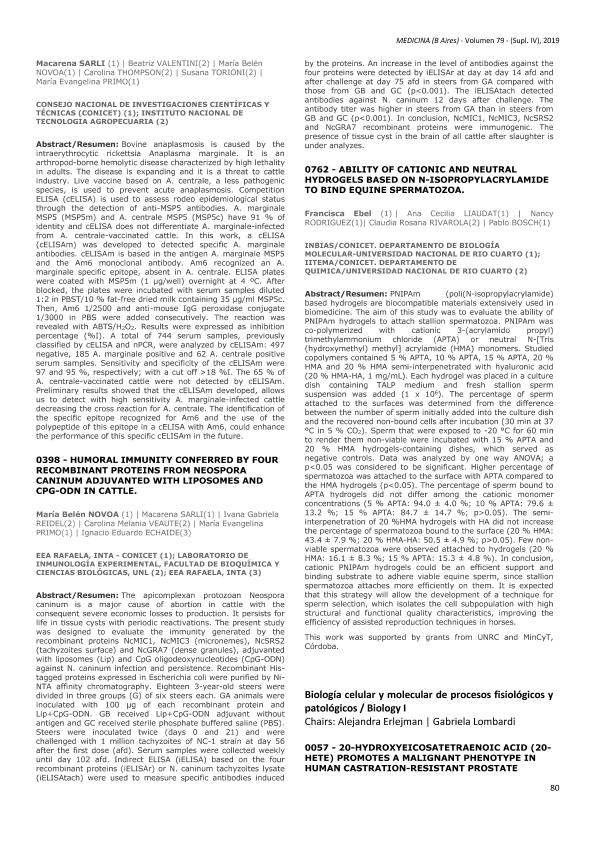Evento
20-Hydroxyeicosatetraenoic acid (20-hete) promotes a malignant phenotype in human castration-resistant prostate cancer cells through stimulation of the g protein-coupled receptor gpr75
Cardenas, Sofia; Colombero, Cecilia; Panello, Laura; Dakarapu, Rambabu; Falck, John; Costas, Monica Alejandra ; Nowicki, Susana
; Nowicki, Susana
 ; Nowicki, Susana
; Nowicki, Susana
Tipo del evento:
Reunión
Nombre del evento:
LXIV Reunión Anual de la Sociedad Argentina de Investigación Clínica (SAIC); LI Reunión Anual de la Asociación Argentina de Farmacología Experimental (SAFE); XXI Reunión Anual de la Sociedad Argentina de Biología (SAB); XXXI Reunión Anual de la Sociedad Argentina de Protozoología (SAP) y IX Reunión Anual de la Asociación Argentina de Nanomedicinas (NANOMED-ar)
Fecha del evento:
13/11/2019
Institución Organizadora:
Sociedad Argentina de Investigación Clínica;
Asociación Argentina de Farmacología Experimental;
Sociedad Argentina de Biología;
Sociedad Argentina de Protozoología;
Asociación Argentina de Ciencia y Tecnología de Animales de Laboratorio;
Asociación Argentina de Nanomedicinas;
Título de la revista:
Medicina (Buenos Aires)
Editorial:
Fundación Revista Medicina
ISSN:
0025-7680
e-ISSN:
1669-9106
Idioma:
Español
Clasificación temática:
Resumen
20-Hydroxyeicosatetraenoic acid (20- HETE), the product of 20-hydroxylation of arachidonic acid by cytochrome P450 isoforms (CYP4F2 and CYP4A11), has a role in the oncogenesis of several human tumors. Recently, the GPR75 receptor has been identified as the target for 20-HETE. We have shown that androgen independent prostate cancer cells (PC-3) express GPR75. The aim of this study was to assess in vitro if 20-HETE/GPR75 modify the metastatic features of PC-3 cells. Cells were incubated with 20-HETE or its stable analog 5,14- HEDGE (both 0.1 nM) in the presence or absence of two different antagonists of the 20-HETE receptor, AAA or 19-HEDE (both 5 or 10 uM). The following assays were performed: e-cadherin and vimentin protein expression (epithelial-mesenchymal transition), zymography (release of matrix metalloproteinase-2 (MMP-2)), immunofluorescence and p-FAK (changes of cytoskeleton), scratch wound healing (migration), and soft agar colony formation (anchorage-independent growth). Results were analyzed using one-way ANOVA followed by Dunnet’s. 20-HETE (24 h) increased by 150 % the expression of vimentin (p<0.0001, n= 3) and diminished by 40 % the expression of ecadherin (p<0.0001, n= 3), whereas these effects were reversed by AAA (p<0.0001 and p<0.05, respectively). 20-HETE increased by 52 % the release of MMP-2 (p<0.05, n= 3), and this was also inhibited by AAA (p<0.001). AAA disorganized the actin filaments throughout PC-3 cells, while tubulin filaments remained unchanged. Also, 20-HETE increased by 89 % FAK phosphorylation (Y397) (p<0.0001, n= 3). 20-HETE increased by 147 % cell migration rate (p<0.0001, n= 3) and this effect was reverted by both antagonists, AAA or 19-HEDE (p<0.05 and p<0.0001, respectively), or by knockdown of GPR75 (p<0.0001). Finally, 5,14-HEDGE (21 days) formed twice the number of colonies vs. control (p<0.05, n= 2) and this was abolished by AAA (p<0.05). These results strongly suggest a role for GPR75 in 20-HETE-mediated metastatic features in PC-3 cells.
Palabras clave:
CANCER DE PROSTATA
,
EICOSANOIDES
,
RECEPTOR GPR75
Archivos asociados
Licencia
Identificadores
Colecciones
Eventos(CEDIE)
Eventos de CENTRO DE INVESTIGACIONES ENDOCRINOLOGICAS "DR. CESAR BERGADA"
Eventos de CENTRO DE INVESTIGACIONES ENDOCRINOLOGICAS "DR. CESAR BERGADA"
Eventos(IDIM)
Eventos de INST.DE INVEST.MEDICAS
Eventos de INST.DE INVEST.MEDICAS
Citación
20-Hydroxyeicosatetraenoic acid (20-hete) promotes a malignant phenotype in human castration-resistant prostate cancer cells through stimulation of the g protein-coupled receptor gpr75; LXIV Reunión Anual de la Sociedad Argentina de Investigación Clínica (SAIC); LI Reunión Anual de la Asociación Argentina de Farmacología Experimental (SAFE); XXI Reunión Anual de la Sociedad Argentina de Biología (SAB); XXXI Reunión Anual de la Sociedad Argentina de Protozoología (SAP) y IX Reunión Anual de la Asociación Argentina de Nanomedicinas (NANOMED-ar); Mar del Plata; Argentina; 2019; 80-81
Compartir



